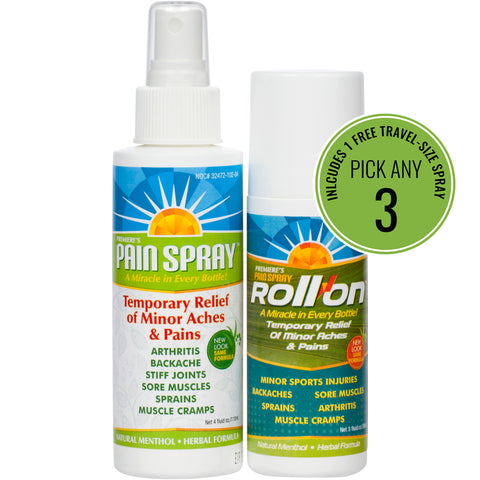
Test Your Pain Tolerance Using These 6 Factors
Remember when people considered individual pain tolerance to be the reflection of willpower? Today that theory seems as silly as thinking the earth is flat. Modern scientific research is showing that a mix of genes, brain chemistry, and life experiences all go in to determining personal pain tolerance.
Factor #1: Genes Play a Role in Determining Personal Pain Tolerance
Heredity plays a big role! In fact, recent studies indicate that pain tolerance is primarily the result of individual variations in the human gene “COMT” (catechol-o-methyltransferase).
You get a copy of COMT from each parent, carrying one of two amino acids (valine or methionine). Most babies inherit some of each, so they have an average pain tolerance. Those with only valine-carrying genes can tolerate significantly more pain. Those with only methionine-carrying genes cannot tolerate much pain at all.
Factor #2: Gender Also Contributes to Pain Tolerance
Research shows that women generally have lower pain tolerance than men. Women are also more likely to develop painful medical conditions. And report higher levels of pain than men do, even when experiencing the same medical problem.
So gender is a second major factor in determining personal pain tolerance.
Ironically, evidence also shows that American women are dramatically under-treated for pain.
For example, several studies have compared doctor response to both male and female “mock patients.” Even when they complain about exactly the same symptoms and report similar levels of pain, women are admitted to the hospital less often. And doctors are less likely to write them prescriptions for pain relief medication.
Factor #3: “Pain Memory” Matters When Determining Personal Pain Tolerance.
Scientists know there are cells throughout the body that actually retain “pain memory.” In some people, these cells are especially active, and the connections between them are very strong. For these individuals, even a mild body ailment produces high levels of pain.
For them, something like short-term back injury pain can last for weeks (or even months). In extreme cases, pain sensitivity can be so bad that the person can’t even tolerate clothes touching their skin.
Phantom limb pain is a great example of pain memory. When a limp is amputated, patients continue to feel pain in that missing arm or leg. Why? Because these special cells (called neurons) actually store a “memory” of the pain.
And it doesn’t take a lot to create that memory. Some experts say that pain lasting for more than just a few minutes will leave a memory track.
Doctors think this phenomenon contributes to the development of chronic pain conditions like fibromyalgia, carpal tunnel, or rheumatoid arthritis.
Factor #4: Childhood Pain Makes You More Pain Sensitive.
Many studies have explored the long-term impact of childhood pain. Most find that an early experience of significant physical pain will impact pain tolerance forever. In other words, the more pain you feel as a chid, the more afraid and hyper-sensitive you are to pain as an adult.
This is true for relatively normal childhood pain experiences, like dental discomfort. It’s also true for injury-related pain, like serious burns. And it is true for survivors of childhood cancer, who often endured painful tests and therapies. All these groups of people are at increased risk for low pain tolerance.
Factor #5: Child Abuse is Key in Determining Personal Pain Tolerance.
Scientists have known for years that early trauma affects brain structure and development. So it isn’t a shock to learn that physical, emotional, or sexual child abuse changes brain wave patterns. And over time those change can create a permanent (and sometimes intense) stress response.
Studies also show that low pain tolerance and chronic pain may actually be a complication of that stress response. In other words, child abuse not only makes you more pain sensitive, it also makes you more prone to developing chronic pain conditions.
Factor #6: Pain Breeds More Pain
More recently, pain researchers made an unfortunate discovery: the longer pain exists, the more intensely you feel it. So a history of pain is another important factor in determining individual pain tolerance.
It occurs because of the way our brains work. It’s almost like the human brain can develop a pain habit. Each time it perceives a particular discomfort, the brain become more inclined to feel it again. Faster and with equal intensity. This is true even if the physical cause has diminished.
So the more times you feel a certain pain, the less stimulus you require to feel it again. For someone with a permanent pain condition this means that your pain level may stay the same even though your condition is medically under control.
Beat Heredity with All-Natural Products!
When pain strikes, many people quickly reach for over-the-counter relief, like aspirin or ibuprofen. However, frequent use of these non-steroidal anti-inflammatory drugs (NSAIDs) can lead to serious medical risk, including internal bleeding, high blood pressure, and liver damage.
That makes all-herbal products appealing. Premiere’s Pain Spray Mist or Roll-On are just two examples. Safe for adults, teens and children (ages 5 and up), these pure menthol pain relief formulas work fast and have no harmful side effects. The more you spray, the more relief you feel. No numbness. No drowsiness.

